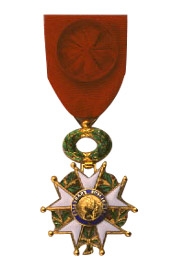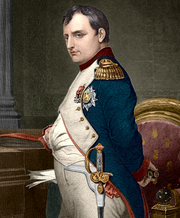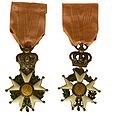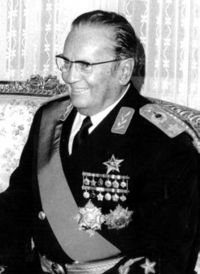Legion of Honour
| National Order of the Legion of Honour Ordre national de la Légion d'honneur |
|
|---|---|
 Officier medal of the French Légion d'honneur |
|
| Awarded by France | |
| Type | Order with five degrees |
| Awarded for | Excellent civil or military conduct delivered, upon official investigation |
| Status | Open since 1802 |
| Statistics | |
| Established | 19 May 1802 |
| First awarded | 14 July 1804 |
| Distinct recipients |
The maximum quotas: Knight: 125,000 Officer: 10,000 Commander: 1,250 Grand Officer: 250 Grand Cross: 75 |
| Precedence | |
| Next (higher) | None |
| Next (lower) | Ordre de la Libération |
Ordre de la Légion d'honneur streamer
|
|
The Legion of Honour, or in full the National Order of the Legion of Honour (French: Ordre national de la Légion d'honneur)[1] is a French order established by Napoleon Bonaparte, First Consul of the First Republic, on 19 May 1802. The Order is the highest decoration in France and is divided into five various degrees: Chevalier (Knight), Officier (Officer), Commandeur (Commander), Grand Officier (Grand Officer) and Grand Croix (Grand Cross).
The order's motto is Honneur et Patrie ("Honour and Fatherland"), and its seat is the Palais de la Légion d'Honneur on the left bank of the River Seine in Paris.[2]
Contents |
History
Consulat
In the French Revolution all French orders of chivalry were abolished. It was the wish of Napoleon Bonaparte, the First Consul and de facto sole ruler, to create a reward to commend civilians and soldiers and from this wish was instituted a Légion d'Honneur,[3] a body of men that was not an order of chivalry, for Napoleon did know that France did not want a new nobility system, but a recognition of merit. The Légion used however the organisation of old French Orders of Chivalry, like the Ordre de Saint-Louis. The badges of the legion do bear a resemblance to the Order of Saint Louis, which also used a red ribbon.

The Légion was loosely patterned after a Roman Legion, with legionaries, officers, commanders, regional "cohorts" and a grand council; and the Emperor angrily rebuked anyone who called this institution an order. The highest rank was not a grand cross but a grand aigle (great eagle), a rank that wore all the insignia common to grand crosses. The members were paid, the highest of them extremely generously:
- 5,000 francs to a grand officier,
- 2,000 francs to a commandeur,
- 1,000 francs to an officier,
- And 250 francs to a légionnaire.

According to some sources Napoleon declared: On appelle ça des hochets, je sais, on l'a dit déjà. Et bien, j'ai répondu que c'est avec des hochets que l'on mène les hommes. — "We call these children's toys, I know, it's been said already. Well, I replied that it's with such toys that one leads men." (The French word hochet means a child's rattle.) This has been often quoted as "It is with such baubles that men are led."
The order was the first modern order of merit. The orders of the monarchy were often limited to Roman Catholics and all knights had to be noblemen. The military decorations were the perks of the officers. The Légion, however, was open to men of all ranks and professions. Only merit or bravery counted. The new legionnaire had to be sworn in the Légion.
It is noteworthy that all previous orders were crosses or shared a clear Christian background, whereas the Légion is a secular institution. The jewel of the legion has five arms.
First Empire

In a decree issued on the tenth Pluviose XIII (30 January 1805) a grand decoration was instituted. This decoration, a cross on a large sash and a silver star with an eagle became known as the Grand Aigle, and later in 1814 as the grand cordon (French for "large sash"). After the reestablishment of the nobility in 1808, award of the Légion gave right to the title of "Knight of the Empire" (chevalier de l'empire). The title was made hereditary after three generations of grantees.
Napoleon had dispensed 15 golden collars of the legion among his family and his senior ministers. This collar was abolished in 1815.
Although research is made difficult by the loss of the archives, it is known that three women who fought with the army were decorated with the order: Virginie Ghesquière, Marie-Jeanne Schelling and a nun, Sister Anne Biget.[4]
The Légion d'honneur was prominent and visible in the empire. The Emperor always wore it and the fashion of the time allowed for decorations to be worn most of the time. The king of Sweden therefore refused the order; it was too common in his eyes. Napoleon's own decorations were captured by the Prussians and were displayed in the Zeughaus (armory) in Berlin until 1945. Today, they are in Moscow.
Restoration of the Bourbon Kings in 1814


Louis XVIII changed the appearance of the order, but it was not abolished. This would have angered the 35-38,000 members. The images of Napoleon and his eagle were removed and replaced by the image of King Henry IV, the popular first king of the Bourbon line. Three Bourbon Lilies (fleur-de-lys) replaced the eagle on the reverse of the order. A king's crown replaced the imperial crown. In 1816 the grand cordons were renamed grand crosses and the legionnaires became knights. The king decreed that the commandants were now commanders. The legion became the second order of knighthood of the French monarchy, after the Order of the Holy Spirit.
July Monarchy

France's first constitutional monarch, King Louis-Philippe of the House of Orleans, restored the order of the Légion d'honneur in 1830 as the paramount decoration of the French nation. The insignia were drastically altered. The cross now displayed tricolour flags. Louis-Philippe abolished the other orders of the monarchy. In 1847, there were 47,000 members.
Second Republic
Yet another revolt in Paris (1848) brought a new republic and a new design to the Légion d'honneur. A nephew of the founder, Prince Napoleon was elected president and he restored the image of his uncle on the crosses of the order. In 1852 the first recorded woman, Angélique Duchemin an old revolutionary of the 1789 uprising against the absolute monarchy, was admitted into the order. President Napoleon staged a coup d'état and made himself emperor of the French in 1852.
Second Empire
An Imperial crown was added. During Napoleon III's reign the first American was admitted: Dr. Thomas Wiltberger Evans, dentist of Napoleon III.
Third Republic
In 1870 the defeat of the army in the Franco-Prussian war brought another Republic. As France changed, the Légion d'honneur changed as well. The crown was replaced by a laurel and oak wreath. In 1871, during the Paris Commune, the Hôtel de Salm, headquarters of the Légion, was burned to the ground in street fighting; the archives of the order were lost.
In the second term of Jules Grévy, newspaper journalists brought to light the trafficking of Grévy's son-in-law, Daniel Wilson, in the awarding of decorations of the Légion d'Honneur. Grévy was not accused of personal participation in these scandals, but he was slow to accept his indirect responsibility, which caused his eventual resignation on 2 December 1887.
During the First World War, some 55,000 decorations were conferred, 20,000 of which to foreigners. The large number of decorations results from the new posthumous awards authorised in 1918. Traditionally membership in the Légion could not be awarded posthumously.
Current organisation and officers
The President of the French Republic is the Grand Master of the Order and appoints all other members of the Order—by convention, on the advice of the Government. Its principal officers are the Chancellor and Secretary-General.
Current officers of the Order include:
- Grand Master: Nicolas Sarkozy
- Grand Chancellor: General Jean-Louis Georgelin since the 9th of June 2010
- Secretary-General: Luc Fons since 2007
The Grand Master's insignia is the Grand Collar of the Legion. Only the President of the Republic, as Grand Master of the Order, wears a Grand Collar.
French nationals, men and women, can be received into the légion, for "eminent merit" (mérites éminents) in military or civil life. In practice, in current usage, the order is conferred, in addition to military recipients, to many entrepreneurs, high-level civil servants, sport champions[5] in as well as other people with high connections in the executive. The members of the French Parliament cannot receive the order, except for valour in war, and ministers are not allowed to nominate their accountants.
French nationals initially always enter the légion at the class of chevalier (knight). To be promoted to a higher class, one must prove new services to France and a set number of years must pass between appointment and promotion. The only exception is the President of the Republic, who is made a grand cross ipso facto upon his accession to the presidency. Foreigners are not admitted in the légion as such, but may be decorated with the insignia of the légion. A foreigner can be decorated directly with the insignia of a higher class. Foreign heads of state and the wives or consorts of monarchs are made Grand Cross as a courtesy.
Another man awarded with the Légion d'honneur was Gustave Camoin- a reporter for Agence France Presse. His award was for reporting the scuttling of the French Fleet off Toulon against the wishes of the Gestapo and Germans. For this, he suffered an all night interrogation by the Gestapo, but they could not harm him as he was a public figure. Camille Papin Tissot a French radio pioneer, experimental physicist, Légion d’honneur en 1901, officier légion d’honneur en 1909.
The Order has a maximum quota of 75 Grand Cross, 250 Grand Officers, 1,250 Commanders, 10,000 Officers and 113,425 (ordinary) Knights. As of 2000 the actual membership was 61 Grand Cross, 321 Grand Officers, 3,626 Commanders, 22,401 Officers and 87,371 Knights.
Appointments of veterans of the Second World War, French military personnel involved in the North African Campaign and other foreign French military operations, as well as wounded soldiers, are made independently of the quota.

In 1998, all surviving veterans of the First World War from any allied country who had fought on French soil were made Knights of the Légion if they were not so already, as part of the commemoration of the 80th anniversary of the war's end. In December 2004, on the occasion of his 110th birthday, France's oldest surviving veteran of the war, Maurice Floquet, was promoted to Officer. On 9 and 16 March 2009, Harry Patch and Henry Allingham were also promoted to Officer.
Members convicted of a felony (crime in French) are dismissed de jure from the order. Members convicted of a misdemeanour (délit in French) can be dismissed too.
Wearing the decoration of the Légion d'honneur without having the right to do so is an offence. Wearing the ribbon or rosette of a foreign order of knighthood is prohibited if that ribbon is mainly red, like the ribbon of the Légion.
French military members in uniform must salute other military members in uniform wearing the medal, whatever the Légion d'honneur rank and the military rank of the bearer. This is not mandatory with the ribbon. However, in practice, this is rarely done.
Collective appointments can also be made to cities, institutions, companies, or military units. In the case of a military unit, its flag is decorated with the insignia of a knight, which is a different award than the fourragère. Cities proudly display the decoration in their coat of arms.
Twenty-one schools, mainly higher educations schools providing the bulk of reserve officers during World Wars, were awarded the Légion d'honneur. They share this distinction with the Red Cross, the abbey of Our Lady of Dombes and the state-railway company SNCF.
Classes and insignia
.svg.png)
The order has five levels:
- Three ranks :
- Chevalier (Knight) formerly légionnaire: badge worn on left breast suspended from ribbon.
- Officier (Officer): badge worn on left breast suspended from a ribbon with a rosette.
- Commandeur (Commander) formerly commandant: badge around neck suspended from ribbon necklet.
- Two dignities :
- Grand Officier (Grand Officer): badge worn on left breast suspended from a ribbon, with star displayed on right breast.
- Grand Croix (Grand Cross) formerly grande décoration, grand aigle or grand cordon: the highest level; badge affixed to sash worn over the right shoulder, with star displayed on left breast.
The sitting President of the Republic, as grand master of the order, wears the Grand Collar of the Légion, which is presented to him upon his investiture.
The badge of the Légion is a five-armed "Maltese Asterisk" (for want of a better description — see Maltese Cross) in gilt (in silver for chevalier) enamelled white, with an enamelled laurel and oak wreath between the arms. The obverse central disc is in gilt, featuring the head of Marianne, surrounded by the legend République Française on a blue enamel ring. The reverse central disc is also in gilt, with a set of crossed tricolores, surrounded by the Légion's motto Honneur et Patrie (Honour and Fatherland) and its foundation date on a blue enamel ring. The badge is suspended by an enamelled laurel and oak wreath.
The star (or "plaque") is worn by the Grand Cross (in gilt on the left chest) and the Grand Officer (in silver on the right chest) respectively; it is similar to the badge, but without enamel, and with the wreath replaced by a cluster of rays in between each arm. The central disc features the head of Marianne, surrounded by the legend République Française (French Republic) and the motto Honneur et Patrie.
The ribbon for the medal is plain red.
The badge or star is not worn usually, except at the time of the decoration ceremony or on a dress uniform or formal wear. Instead, one normally wears the ribbon or rosette on one's suit.
Gallery
 Original Légionnaire insignia (1804). |
 Late Empire Légionnaire insignia: the front feature Napoleon's profile and the rear, the imperial Eagle. An imperial crown joins the cross and the ribbon. |
 Louis XVIII era (1814) Knight insignia: the front features Henry IV's profile and the rear, the arms of the French Kingdom (three fleurs de lis). A royal crown joins the cross and the ribbon. |
 Rear of a Republican cross, with two crossed French flags. |
Fifth Republic Knight insignia: the centre features Marianne's head. A crown of laurels joins the cross and the ribbon. |
 Current medal for the officer class, decorated with a rosette. |
 Chiang Kai-shek's Légion d'honneur plaque. In his days the plaque was made of silver. |
 Chiang Kai-shek's Légion d'honneur. This is the reverse of his Grand Cross. |
 The insignia of a Grand Cross. Nowadays the star of a Grand Cross is gilt. The silver star is the Grand Officer's badge. |
Foreign recipients

Technically, membership in the Légion is restricted to French nationals.[6] Foreign nationals who have served France or the ideals it upholds[7] may, however, receive a distinction of the Légion, which is nearly the same thing as membership in the Légion. Foreign nationals who live in France are submitted to the same requirements as Frenchmen. Foreign nationals who live abroad may be awarded a distinction of any rank or dignity in the Légion.
Military Units
The pole of the Flag or the standard units or following training, was awarded the Cross of the Legion of Honor. [8]:
- 3nd Foreign Regiment (Regiment walk from the Foreign Legion).
- 1st Foreign Regiment.
- Infantry-tank Regiment Marine (Colonial Infantry Regiment of Morocco). Book of the regiment will be fighting its most decorated emblem of the French army.
- 1st Marine Infantry Parachute Regiment
- 1st Marine Infantry Regiment.
- 2nd Marine Infantry Regiment.
- 23nd Marine Infantry Regiment.
- 24nd Marine Infantry Regiment.
- 43rd Marine Infantry Regiment.
- 1st Marine Artillery Regiment.
- 11th Marine Artillery Regiment.
- 1st Battalion of Chasseurs.
- 1st Train Regiment.
- 8th Infantry Regiment.
- 23rd Regiment Infantry.
- 26th Regiment Infantry.
- 51st Infantry Regiment.
- 57th Regiment Infantry.
- 137th Infantry Regiment.
- 152nd Infantry Regiment.
- 153rd Infantry Regiment.
- 298th Infantry Regiment.
- 1st Regiment of Riflemen.
- 1st Regiment of Algerian Riflemen.
- 2nd Regiment of Algerian Infantry.
- 3rd Algerian Infantry Regiment.
- 7th Algerian Infantry Regiment.
- Moroccan Goumier.
- 4th Regiment of Tunisian Riflemen.
- 1st Regiment of Senegalese Riflemen.
- 1st Regiment of African Hunters.
- 2nd Regiment of Zouaves.
- 3rd Regiment of Zouaves.
- 4th Regiment of Zouaves.
- 8th regiment of Zouaves.
- 9th Regiment of Zouaves.
- Joint 4th Regiment of Zouaves and Sharpshooters.
- Fire Brigade of Paris.
- Battalion of marines.
- Fighter Squadron 1 / 30 Normandie-Niemen | Regiment Normandie-Niemen fighter (Air Force).
Locations associated with the Order
A grand total of 68 cities and villages, amongst them Liège in 1914, Belgrade in 1920, Luxembourg in 1957 and Stalingrad (today's Volgograd) in 1984 were decorated, as were 51 regiments and the Military School of Autun.
The Order has its own élite boarding schools in Saint-Denis and Les Loges in the forest of Saint-Germain-en-Laye. A thousand children and grandchildren of the members of the order are educated there. Study there is restricted to daughters, grand-daughters, and great-grand-daughters of members of the order, the Médaille militaire or the Ordre national du Mérite.[9]
See also
- List of Légion d'honneur recipients by name
- List of prizes, medals, and awards
- Musée national de la Légion d'Honneur et des Ordres de Chevalerie
- Order (decoration)
- Order of the Garter
- Order of the Golden Fleece
- Ordre de la Libération
- Ordre National du Mérite
- Ribbons of the French military and civil awards
- State decoration
References
- ↑ Formerly the Royal Order of the Legion of Honour (Ordre royale de la Légion d'honneur)
- ↑ The award for the French Legion of Hono(u)r is known by many titles, also depending on the five levels of degree: Knight of the Legion of Honour; Chevalier de la Légion d'honneur; Officer of the Legion of Honour; Officier de la Légion d'honneur; Commander of the Legion of Honour; Commandeur de la Légion d'honneur; Grand Officer of the Legion of Honour; Grand Officier de la Légion d'honneur; Grand Cross of the Legion of Honour; Grand'Croix de la Légion d'honneur. The word "honneur" is often capitalised, as in the name of the palace Palais de la Légion d'Honneur.
- ↑ Pierre-Louis Roederer, "Speech Proposing the Creation of a Legion of Honour", Napoleon: Symbol for an Age, A Brief History with Documents, ed. Rafe Blaufarb (New York: Bedford/St. Martin's, 2008), 101-102.
- ↑ The first recorded women's award is 1851, under Louis-Napoleon Bonaparte.
- ↑ All Olympic Gold Medal winners are awarded the Légion.
- ↑ Légion Code, article 16
- ↑ Les étrangers qui se seront signalés par les services qu’ils ont rendus à la France ou aux causes qu’elle soutient, Légion Code, art. 128
- ↑ Do not confuse military units that received the fodder to the color of the ribbon of the Legion of Honour (units quoted at six, seven or eight times in the order of the army] with military units that received the Cross of the Legion of Honour
- ↑ Melh.info
External links
- Legiondhonneur.fr (French)
- French Embassy in Canada article, ambafrance-ca.org
|
|||||||||||||||||||||||||||||||||||||||||||||
|
||||||||